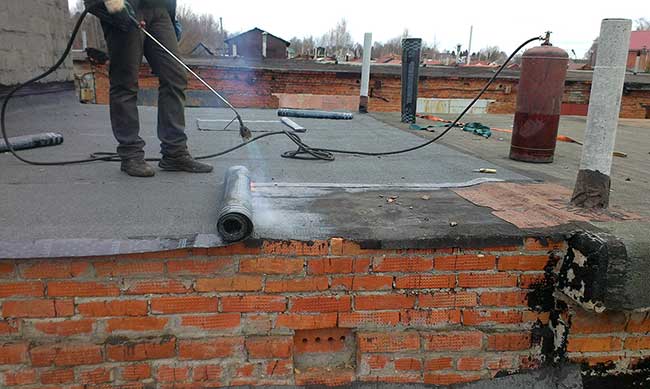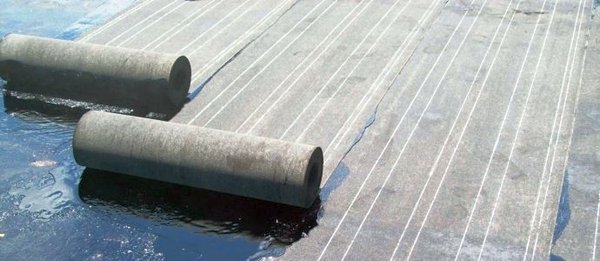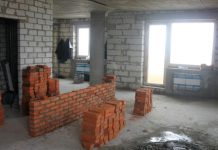In detail: do-it-yourself garage roof repair from a real master for the site my.housecope.com.
A garage roof leak risks not only damage to building structures and the need for serious repairs. Water trapped inside a building can damage tools, equipment and materials in storage. Repair of a soft roof of a garage usually does not require special preparation and can be done independently.
The roof is the most vulnerable place of the building, since it is exposed to the most destructive atmospheric influences. The resistance of a soft roof to external influences directly depends on the characteristics of the coating material. Most often, it is an affordable roofing material, but modern fused materials can also be used to equip a garage roof.
At the preliminary stage of repairing the roofing with your own hands, you should carefully examine the roof in order to determine the degree of damage to the flooring. If there is some damage on the surface, you can limit yourself to local repair of the corresponding sections of the roof deck. Serious deterioration of the coating is the reason for replacing the entire roofing carpet or creating a new outer layer of the roof from roll material, mastic or liquid rubber.
If the garage has a roof with a slope of at least 5 degrees, then the repaired roofing carpet made of roll materials can be left as a waterproofing coating, the sheathing can be mounted on top of it and the roofing can be laid from a suitable sheet material.
Depending on the results of the roof audit, a repair method is selected and the required amount of materials is purchased.
| Video (click to play). |
Before proceeding with the restoration of the soft roofing with your own hands, the entire surface of the flooring should be thoroughly cleaned of debris and all types of dirt, and dried mastic should be removed. In places of through holes in the coating, the outer layer is opened by means of a cruciform notch ("envelope"), the edges are folded back, dirt and moisture are removed from the base. Areas with badly worn roofing felt should be cut out with an ax. Further, it is required to dry the roofing well, paying special attention to the opened places before local repairs - they are most efficiently dried using a construction hairdryer or a gas burner.
Preparatory and repair work must be carried out only in dry weather during the warm season - the air temperature must be at least 10 ° C.
To repair individual sections of the soft roof, you will need bitumen mastic and roofing material. In the opened prepared "envelope" it is required to put a piece of roofing material, cut exactly to the size of the envelope, after thoroughly smearing the hole with well-heated bitumen in order to exclude the possibility of moisture penetration into the inner layers of the roofing carpet. A layer of bitumen mastic is applied over the laid inner patch and the folded edges of the "envelope" are pressed tightly. The outer patch should extend 15-20 cm beyond the edges of the repaired area. A cut piece of roofing material of the required size is also glued with mastic. For maximum reliability, it is coated on top with a layer of bitumen (special attention is paid to the edges adjacent to the roof), and sprinkled with a layer of sand... After the mastic has dried, the excess sand should be removed.
If a worn-out piece is cut out in the coating, the resulting cavity is filled with roofing material of appropriate sizes and heated bitumen.The external patch is laid according to the above technology.
To ensure reliable adhesion of the patch to the existing roof deck, it is recommended to remove the outer protective layer of roofing material, consisting of fine-grained mineral chips. To do this, you can use solar oil, which will soften the material, and a metal spatula... The oil is applied with a brush or brush.
If a roofing material roof has traces of general wear and tear due to aging of the material under the influence of ultraviolet radiation, temperature drops and moisture, which is expressed in a frequent network of small cracks along the entire surface of the flooring, it can be restored with your own hands using:
Bituminous mastic is used in a heated form. The repair compound is applied with a brush to the roofing material. The mastic fills the cracks and provides the required level of waterproofing of the material. This type of repair does not require serious financial costs, it is available for doing it yourself, but it is important to observe safety precautions when working with heated resin. In addition, during the work, it is recommended to cover the surface already treated with mastic with a layer of sand, which will protect the bitumen material from the destructive effects of ultraviolet radiation and extend the service life of the repaired roof.
Liquid rubber - a more technological and durable coating... This repair compound is a water-based bitumen-polymer emulsion. After drying, the material applied to the roofing acquires the properties of rubber and provides high-quality waterproofing of the surface. If working with two-component liquid rubber requires the use of special equipment, then an affordable cold one-component material can be applied with your own hands using a spatula, brush or roller. The coating successfully withstands temperature extremes, exposure to moisture, UV radiation, and aggressive environments.
To renew the outer covering of a garage soft roof, you can use traditional roofing felt or weldable roll material. The first option is cheaper, but the complexity of installation is higher. In the second case, you need to use a gas burner.
Roofing material is laid on top of a layer of heated bitumen mastic. The bituminous composition is applied to the prepared roof surface in a strip slightly exceeding the width of the roofing material. Roll material is rolled on top, and care should be taken to avoid the formation of bubbles. The overlap of the next strip should be 10-15 cm - it is for this width that the edge of the already laid coating should be smeared with bitumen. Discovered bubbles should be opened by making a small incision. After removing air from the area under the coating, the roofing material must be pressed tightly to the surface and the incision must be smeared with bitumen.
The finished flooring layer should be left to dry for 12 hours. Then the installation of the next layer of carpet is carried out - it should be done with a slight shift in order to avoid overlapping joints. In this case, the roof covering is able to provide the required degree of waterproofing. The number of layers of roofing material in a waterproofing carpet depends on the characteristics of the roof:
- 5 layers for flat roofs;
- 4 layers with a low slope (less than 15 degrees);
- 3 layers with a slope of 20-40 degrees;
- 2 layers on slopes from 45 degrees.
The lower layers of the carpet are made of fine-grained roofing felt or roofing felt, and for the outer covering it is recommended to roll material with coarse-grained dressing, which is maximally resistant to external influences.
Installation of the welded roof can also be done by hand. The cleaned and dried roof is primed with bitumen. Then the roll of material is rolled out about half a meter, and the free end is thoroughly heated with a gas burner. It is important to heat the corners and edges of the coating well to prevent them from lagging behind the surface..
The heated piece of the deposited coating is pressed against the roof surface with a roller. Then the roll is rolled out again by 50-60 centimeters, and the wrong side of the material is well heated by the burner. The strips of material are mounted with an overlap of 7-8 centimeters. The roofing carpet should consist of at least two layers, laid with shear joints. Work on the installation of the welded roof should be done accurately and quickly. It is not recommended to walk on the finished coating until it cools completely - this can lead to a violation of the waterproofing properties of the material.
The optimal choice of repairing garage roofing will ensure the reliability of the roof of the building and protect the property for a long time.
For a man, a garage is practically a home. It is also a "hobby club" and a place where the opportunity to show skill is accompanied by the work of engineering. The owner is solely responsible for rearranging and cleaning the garage. He often repairs himself, because it is undesirable to trust strangers to restore all categories of order in your favorite possessions.
In addition, the process of restoring the technical condition of an adored property sometimes brings real pleasure and increases self-esteem. An independent repair of the roof of a garage roof is quite accessible to a home craftsman, if he is armed with information on how to perform it.
The roof of buildings of any type, size and purpose tends to wear out, to the great regret of the owners. Heavy gusts of wind, hail, torrential rains, birds, abandoned stones and suddenly fallen trees are regularly tested for its strength. Similar factors with equal constancy attack the roofs of garages, which sometimes do not cause as much concern to owners as a leaking ceiling in an apartment. Because of absolutely unjustified frivolity, the beloved "iron horse" or "swallow", slowly rusting from an excess of moisture, suffers not like a child.
Leaks are a clear indicator of a violation of the integrity of the roof or flaws in the construction of the roofing pie. However, you should not wait for the appearance of smudges on the walls and ceiling. In order not to face serious facts that require expensive repairs, it is necessary to carry out preventive inspections of the upper garage ceiling from the outside at regular intervals 4 times a year and monitor the condition of the ceiling daily.
Garage roofs, like the buildings they cover, are a term that combines a wide range of structural varieties. They are erected over standard free-standing boxes, and over lined up garage boxes, and over household structures of vast private estates. They are single and gable, hipped, mansard, etc. They can be equipped with any of the existing types of roofing materials, the choice of which depends on the status and financial capabilities of the owners.
Regardless of the cost of the material used in the arrangement, the repair of the garage roof is the inevitable result of its service. Of course, the more resistant the coating is to destructive factors, which is almost always directly related to the price, the less often it will be necessary to restore its technical perfection. True, durability rarely coincides with the ability to lay and repair it yourself. Therefore, adherents of soft coatings predominate in the ranks of independent owners of car houses, and most often they are used in construction and repair:
- Bituminous-polymer descendants of roofing material for the repair of single-pitched garage roofs made of reinforced concrete panels.
- Elastic vulcanized membrane with EPDM markings, popularly known as "rubber roofing". It is used in the repair of similar low-pitched roofs.
- Flexible shingles, which are figuredly cut pieces of bitumen-polymer material used in the arrangement and repair of gable, hip and mansard roofs with slopes from 11º.
In the vastness of the fatherland, they are rarely carried away with bituminous tiles, although this is a quite promising and easily repaired type of coating. It is mainly used when it is required by the aesthetic culture of decorating the estate, made in a single stylistic spirit.
Let us mention that in the field of arranging garage roofs, slate, ceramics, profiled sheets and metal tiles are used. They are much less in demand, and most often they require professional repair. Therefore, we will pay attention to the most common soft options and methods of their restoration.
Damage typical for soft roofing includes punctures, breaks, bulges, creeping of the coating, depressurization of joints and zones of abutment to adjacent walls or to the parapet. Not all of the listed reasons are accompanied by leaks, but, nevertheless, need to be eliminated. According to the degree of application of efforts and costs, repairs are divided into two types:
- Ongoing correction of coating defects. The current repair consists in correcting small single damage and minor flaws in the construction, if the total area of the repaired surface is approximately 10% of the roof area.
- Roof overhaul. It consists in a complete replacement of the damaged coating, performed when 60% of the damaged roof area is found.
There is a noticeable interval between the indicated percentages, which makes it possible for the owner, in fact, to give preference to one or another repair type. He himself will be able to decide what is more profitable, endlessly patch up the gaps, or lay a brand new coating.
Ongoing repair operations involve pinpoint repair of damage. But during the overhaul of the garage roof, the waterproofing carpet is often completely changed, the abutments and joints are again sealed, the drainage funnels, if any, are sealed. You can also change the slope of the slopes, install additional ventilation elements or insulate the roof. However, before making major design changes, you should consult with the designers.
It is especially worthwhile to treat the installation of thermal insulation. It will, of course, reduce heating bills if the car house is heated autonomously. If you have to repair the usual compartment of a long garage complex with a common heating network without heat meters, there is no point in adjusting and saving the supplied energy.
Again, roof insulation can lead to a violation of the temperature regime of car storage. Indeed, according to the clear requirements of SNiP II-93-74, the thermometer scale in the garage should not show above + 5 ° C. In order for the conditions of the car's maintenance to meet the regulated standards, accurate calculations are needed. Otherwise, condensation will appear in the thermal insulation, and its drops will "sharpen" the outer seams and the paintwork of the body all year round.
We will concentrate on the elementary replacement of the coating that meets the efforts of the home craftsman and his level of craftsmanship.
Roof overhaul is carried out in the warm season. It is recommended that the restoration processes coincide with the period with minimal precipitation. Only in case of emergency is it permissible to carry out work in cold and rainy times with the obligatory installation of an awning over the repaired site. The scope of work on the roofs of private garages is usually small, but it is advisable to complete all operations in one day. As a last resort, on the first day of repair, the roof waterproofing should be completely arranged.
Typical work sequence for a complete replacement of the coating:
Repairs can only be carried out at the temperature conditions specified by the manufacturer of the material.Do not work with coatings if the thermometer shows a value below the limit of its frost resistance. In case of an urgent need to carry out laying with minus readings, the material is preliminarily laid in a heated room. The temperature of its adaptation is from 15º to 20ºС, the holding time is not less than 4 hours.
Let's start by preparing the foundation. Removing minor potholes and cracks will not require a significant period of time or much effort. Worse, if the surface of the reinforced concrete floor has noticeably crumbled, if the boards or slabs of solid flooring are rotten. Such troubles require either pouring a cement screed, or installing a new prefabricated base.
We will assume that the laborious process of complete restoration of the base is not our lot. Then we will find out if its moisture allows you to start laying bitumen-polymer waterproofing. The restrictions specified in SNiP 3.04.01-87 allow starting work if the humidity does not exceed 4-5%. Without a device, literally "by eye", it is impossible to determine the exact parameters of humidity, but there are folk methods, these are:
- A small spill of bitumen heated to almost boiling to the surface. If the bitumen starts to bubble, the moisture content is higher than the established norm.
- Laying a piece of polyethylene on the base with a side size of up to a meter. The edges should be fixed around the perimeter with adhesive tape.
If condensation accumulates on the inner surface of the polyethylene, the base must be dried. Close the base section until noon, check in a day.
You can not resort to folk methods of testing if the old roof does not upset with swelling. The base can then be primed immediately with a bituminous primer to optimize adhesion to the waterproofing overlaid, then:
Upon completion of the laying of the coating, metal parts are installed: aprons, fastening strips to parapets and vertical walls, etc.
The quality of the connection of the coating sheets into a single web is judged by the outflow of the binder along the side edge. The width of this protrusion over the edge is 5-15 mm. After laying the next strip, the outflow on the previous element must be carefully trimmed with a spatula. Poor-quality seams with peeling strips are difficult to repair using a torch. It will be more convenient to warm up the defective place with a building hairdryer with a flattened nozzle.
If the flat top floor does not have parapets, then before you start repairing the garage roof with your own hands, a cornice bar should be nailed along the perimeter or where possible. It is needed for the subsequent fastening of the metal strip and for the decoration of the roof edge.
It is possible to repair the roof with bitumen and bitumen-polymer rolls without removing the old roofing material or similar material, if it was soundly repaired during the current repair, and even with the application of a 2-meter lath, recesses more than 5 mm were not detected.
All currently existing types of roofing membranes are suitable for roof repair. However, for a garage, a membrane with an EPDM marking is considered the most acceptable. The material is absolutely indifferent to the neighborhood of the old membrane and the bituminous coating, it is very resistant to atmospheric attacks. And another plus: it is wide, thanks to which the garage roof can be covered with a single piece without seams.
Algorithm for repairing a garage roof with EPDM installation:
At the end, we put in place the cornice strips, elements of the drainage system and aprons.
If it was not possible to do without butt seams, we glue the EPDM panels with an adhesive with a synthetic rubber base. The above compositions cannot be used to form the seams of the material.
Owners of garages with passages through the roof of communications and with abutments to walls or parapets will need to glue additional layers of reinforcement on top of the coating. Reinforcement carpets around drainage funnels, aerators, pipes are rounded.The size is calculated so that the edge of the reinforcement recedes from the edge of the hole by 20-25 cm. Along the abutment line, the reinforcing pad is applied in strips of self-adhesive membrane so that half of the strip falls on the vertical plane and half on the horizontal one.
It is also better to completely replace worn-out bituminous shingles. Especially if you forgot to stock up on the material of the batch that was used in the initial arrangement. The sequence of actions for replacing bituminous tiles resembles the process of repairing a garage roof with roofing felt or a modernized bitumen-polymer coating. The difference is that the shingles are stacked and attached individually. They are not fused, but glued to mastic and fixed with brushed nails or self-tapping screws.
You should be very careful about dismantling work, because unspoiled elements of the coating can be used later. Nails must be carefully pulled out with a nail driver so as not to damage the crate and not provide yourself with additional work on the construction of a new base. After removing the old coating, waterproofing and fasteners, the surface is thoroughly cleaned. Then the reinforcing carpet is laid down again and the covering is laid.
Finally, to refresh the memory of the principle of the simplest repair of the roof of the garage roof with bitumen roll material will help the video:
The described technologies and folk methods of repairing a garage roof will help to put in order the adored property, thanks to which the car will be provided with proper storage conditions with minimal costs.
There are several technologies for repairing a garage roof with your own hands. The choice of a specific method for carrying out restoration work depends on the level of wear of the roof, its type and directly on the type of motorhome.
The restoration of the roofing of a house for a car is currently carried out using three main technologies: soft materials, hot bitumen, tiles or profiled sheets. Private garages are mostly covered with inexpensive and at the same time durable materials - modern ondulin and flexible tiles, corrugated board. You can easily select the optimal method for "treating" the roof of an RV based on the type of roof covering.
Regardless of the technology chosen, you will need to properly prepare the roof for repairs. Inspect the roof, establish the level of its operational wear, determine the roofing elements that must be replaced without fail. In cases where the old coating as a whole is still quite suitable, remove only problem areas by cutting them out with an ax. Subsequently, they can be replaced with new elements, significantly reducing the cost of repair work.
Roof preparation for repairs
If the covering was made with roofing material or a similar material (equipped with a soft roof), swelling and cracks often appear on it over time. Such problem areas need to be dealt with even before the start of repair activities. It is not difficult to do this: cut the defective areas crosswise with a well-sharpened knife; Bend the resulting triangles and clean out debris and dust from them.
When carrying out repairs, such areas with corrected flaws you will need to fill with bitumen. Below we will tell you more about how to correctly perform such an operation. Thoroughly clean the roof surface, rinse with water if necessary. Now you can start recovery activities.











